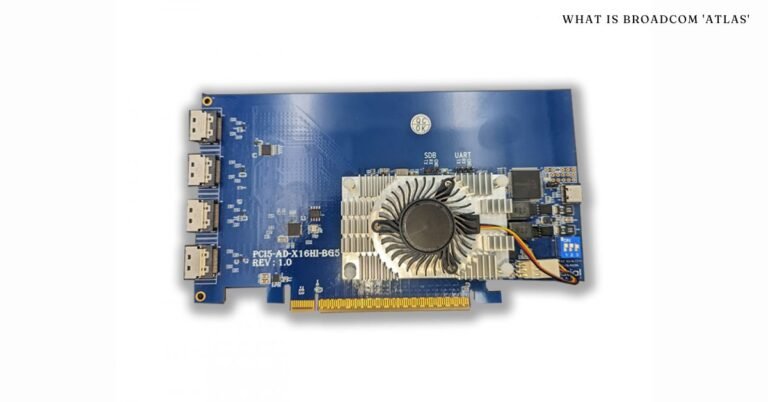Introduction to Broadcom ‘Atlas’
Broadcom, a global leader in semiconductor and infrastructure software solutions, has been at the forefront of cutting-edge technological advancements. One of its latest innovations, known as ‘Atlas,’ is gaining significant attention in the tech industry. But what is Broadcom ‘Atlas’? Simply put, it is a sophisticated system or platform designed to enhance network efficiency, improve semiconductor performance, and optimize data processing. With increasing demands for high-speed networking, cloud computing, and AI-driven analytics, Broadcom’s Atlas emerges as a crucial solution for enterprises, cloud providers, and telecommunications companies.
The primary purpose of Broadcom ‘Atlas’ is to address the challenges posed by modern data infrastructure, including congestion, latency, and scalability. Whether it is powering data centers, improving AI processing, or enabling faster edge computing, Atlas plays a significant role in accelerating innovation. This article delves deep into the architecture, functionalities, benefits, and real-world applications of Broadcom ‘Atlas’ to provide a complete understanding of why it is a game-changer in the semiconductor landscape.
The Architecture and Core Technologies Behind Broadcom ‘Atlas’
The foundation of Broadcom ‘Atlas’ lies in its advanced semiconductor and network processing technologies. At its core, Atlas integrates next-generation processing units, high-bandwidth interconnects, and AI-driven optimization techniques to deliver superior performance. Unlike traditional processing architectures, Atlas employs a multi-layered system that enables efficient data flow and dynamic resource allocation, ensuring that network congestion and inefficiencies are minimized.
Broadcom’s engineers have designed Atlas with a focus on scalability. This means that it can seamlessly handle increasing workloads without compromising on speed or efficiency. The architecture leverages a combination of specialized ASIC (Application-Specific Integrated Circuits) and FPGA (Field-Programmable Gate Arrays) technologies to optimize processing power. Furthermore, the inclusion of AI acceleration capabilities ensures that workloads related to machine learning, neural networks, and deep learning models run with exceptional efficiency.
Another significant feature of Atlas is its energy efficiency. With data centers consuming vast amounts of power, Broadcom has prioritized reducing energy consumption without sacrificing performance. The Atlas architecture integrates power-efficient transistors, advanced cooling mechanisms, and smart energy management techniques to ensure sustainable operations. This makes it an ideal choice for enterprises seeking to lower their carbon footprint while maximizing computing power.
Key Features and Capabilities of Broadcom ‘Atlas’
Broadcom ‘Atlas’ stands out due to its comprehensive set of features that cater to the evolving needs of modern computing environments. Some of the key capabilities include:
1. High-Performance Network Processing
One of the major strengths of Atlas is its ability to handle complex network processing tasks with unparalleled efficiency. It utilizes high-speed packet processing engines that significantly reduce latency, making it ideal for applications in cloud computing, edge computing, and AI-driven analytics. With the exponential rise of IoT devices and connected systems, Atlas ensures that massive amounts of data can be processed in real time without bottlenecks.
2. AI-Driven Optimization
Artificial intelligence is at the heart of Broadcom ‘Atlas,’ enabling it to adapt to changing workloads dynamically. The AI-powered processing units analyze data patterns, predict workload distribution, and optimize resource allocation accordingly. This feature is particularly beneficial for enterprises running large-scale AI models, as it enhances training speeds and inference capabilities while reducing computational overhead.
3. Scalable and Modular Design
Scalability is a crucial factor for businesses operating in the digital era. Atlas features a modular architecture that allows enterprises to expand their computing capabilities based on demand. Whether it’s increasing processing nodes or integrating additional networking components, Atlas provides the flexibility needed to grow with business requirements.
4. Enhanced Security and Data Protection
With cybersecurity threats becoming more sophisticated, Atlas incorporates robust security mechanisms to safeguard data integrity. Features such as end-to-end encryption, real-time threat detection, and AI-driven anomaly detection ensure that sensitive information remains protected against potential cyber threats. These security enhancements make Atlas an excellent choice for financial institutions, government agencies, and enterprises dealing with confidential data.
5. Low Power Consumption and Sustainability
One of the standout aspects of Broadcom ‘Atlas’ is its focus on sustainability. By employing energy-efficient chipsets and optimizing power usage, Atlas reduces operational costs while maintaining top-tier performance. This makes it an attractive solution for organizations looking to balance performance with environmental responsibility.
The Impact of Broadcom ‘Atlas’ on Industries
The introduction of Broadcom ‘Atlas’ is set to revolutionize various industries, offering unprecedented efficiency and performance enhancements. Some of the key sectors that stand to benefit include:
1. Cloud Computing and Data Centers
With the increasing demand for cloud-based services, data centers require robust infrastructure capable of handling massive workloads. Atlas ensures high-speed data processing, low-latency communication, and energy-efficient operations, making it a valuable asset for cloud providers like AWS, Microsoft Azure, and Google Cloud.
2. Telecommunications and 5G Networks
Atlas plays a crucial role in enhancing the performance of 5G networks by optimizing packet routing, reducing latency, and improving spectrum efficiency. Telecommunications companies leveraging Atlas can provide faster and more reliable connectivity, ensuring seamless user experiences for consumers and enterprises alike.
3. Artificial Intelligence and Machine Learning
AI-driven applications demand high processing power and real-time analytics capabilities. Atlas accelerates AI workloads by optimizing neural network computations and improving inference speeds. This leads to faster model training, better predictive analytics, and improved AI-driven decision-making.
4. Automotive and IoT Applications
With the rise of autonomous vehicles and IoT-enabled devices, there is an increasing need for edge computing solutions that can process data in real-time. Atlas enhances the efficiency of automotive AI systems, improves sensor data processing, and ensures seamless communication between connected devices.
Comparison Chart: Broadcom ‘Atlas’ vs. Traditional Computing Architectures
| Feature | Broadcom ‘Atlas’ | Traditional Computing |
|---|---|---|
| Processing Speed | High-speed AI-optimized | Standard multi-core CPUs |
| Scalability | Modular and expandable | Limited scaling capabilities |
| Energy Efficiency | Low power consumption | High energy demands |
| AI Integration | Advanced AI acceleration | Minimal AI optimization |
| Security Features | Real-time threat detection & encryption | Basic encryption mechanisms |
| Use Cases | Cloud, AI, 5G, IoT, Data Centers | General computing, legacy systems |
Future Prospects and Developments for Broadcom ‘Atlas’
As technology continues to evolve, Broadcom ‘Atlas’ is expected to undergo further advancements to keep up with emerging trends. Future developments may include enhanced AI co-processors, deeper integration with quantum computing, and even more energy-efficient chipsets. Additionally, with the rise of edge computing, Atlas is likely to see improvements that enable ultra-low latency applications, making it a crucial component of next-generation infrastructure.
Enterprises looking to stay ahead of the curve should closely monitor updates related to Broadcom ‘Atlas’ and explore opportunities to integrate it into their operations. As AI, cloud computing, and high-performance networking continue to grow, Atlas will play a vital role in shaping the digital landscape of tomorrow.
Conclusion
Broadcom ‘Atlas’ represents a significant leap in computing and networking technology, offering superior performance, scalability, and security. Its AI-driven optimization, energy efficiency, and adaptability make it a valuable asset across various industries, including cloud computing, telecommunications, AI, and IoT. As businesses seek to enhance their technological capabilities, integrating Atlas into their infrastructure could unlock new levels of efficiency and innovation. Whether you are a data center operator, a cloud service provider, or an AI developer, Broadcom ‘Atlas’ is set to redefine the way computing resources are utilized in the modern digital era.

